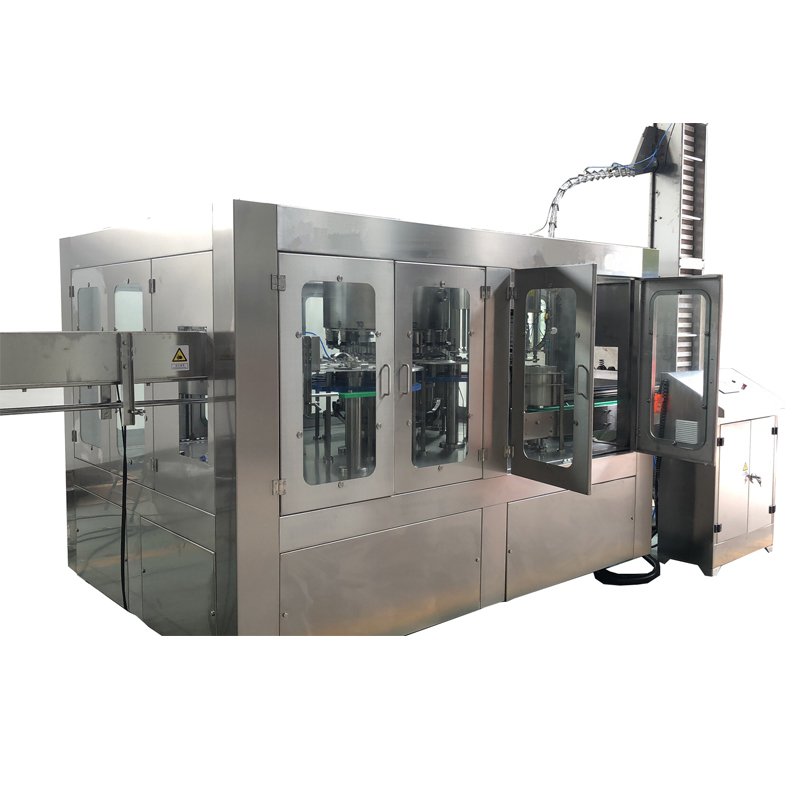Juice filling machine is to fill juice drinks, tea drinks, functional drinks and other beverages without carbon dioxide. In general, the juice filling machine contains gravity filling machine , vacuum filling machine, and overflow filling machine
- Gravity Filling Machines: fill liquid to bottles/containers by liquid’s gravity. It is for filling liquids like water, juices, oils, sauces, beverages, and more.
- Vacuum Filling Machines: The packaging container and the filling machine tank are in the same vacuum. Filling machine fills liquid into bottles by liquid’s gravity. It is for filling liquids into bottles without causing foaming or spillage. We usually use vacuum filling machines for wine, juice, or high-speed filling production line.
- Overflow Filling Machines: The vacuum of the packaging container is greater than that of the filling machine tank. The filling machine fills liquid into the container under pressure differential action. Suitable for filling foamy liquids, these machines ensure consistent fill levels by allowing excess product to overflow. We usually use the overflow filling machine for juice, high speed water filling.
What Is The Filling Temperature Of Juice Filling Machine?
Juice filling has two filling temperatures: high temperature filling and cold filling. The temperature of high-temperature filling is about 88°C. The temperature of cold filling is about 20 ° C, close to room temperature.
Does Juice Need Hot Filling Machine?
Hot filling is a process commonly used for packaging certain types of beverages, including fruit juices, to extend their shelf life and ensure product safety. Hot filling involves heating the juice to a temperature close to or above its pasteurization temperature and then filling the hot liquid into sterilized bottles or containers. The heat helps to kill or reduce harmful microorganisms and enzymes that could spoil the juice or affect its quality. For the Following reasons, we need to use hot filling machine for juice.
- Pasteurization: Hot filling helps to pasteurize the juice, effectively reducing the microbial load and increasing the juice’s shelf life without the need for chemical preservatives. Pasteurization also helps to maintain the flavor, color, and nutritional quality of the juice.
- Natural Preservation: Some juices are packaged without added preservatives. Hot filling provides a natural preservation method by using heat to kill bacteria, yeast, and molds that could cause spoilage.
- pH and Sugar Content: The decision to hot fill juice can depend on its acidity and sugar content. Acidic juices with a lower pH (more acidic) are less favorable for bacterial growth, and higher sugar content can act as a natural preservative. However, even juices with these characteristics might benefit from hot filling to ensure an extended shelf life.
- Container and Closure Selection: The choice of packaging materials, including bottles and caps, can influence the decision to use hot filling. Containers must be able to withstand the high temperature of the filled juice without deforming or compromising the product.
- Product Integrity: Hot filling can help ensure that the juice maintains its taste, color, and nutritional value by inactivating enzymes and microorganisms that can cause deterioration.
- Market and Distribution: If the juice is intended for distribution in areas where refrigeration might not be readily available, hot filling can provide an additional layer of protection against spoilage during storage and transportation.
Is Hot Filling Necessary For Juice Filling Machine?
It’s important to note that not all juices require hot filling. Some juices with higher acidity, sugar content, or added preservatives might be suitable for other filling methods, such as cold filling or aseptic filling, which also aim to maintain product quality and safety.
Do You Need Hot Filling Machine Or Cold Filling Machine?
The decision between using hot filling or cold filling for juice depends on various factors related to your product, packaging, distribution, and desired shelf life.
- Juice pH and Acidity:
Acidic juices (lower pH) are less conducive to microbial growth, which can help extend shelf life. Cold filling might be suitable for juices with higher acidity.
Less acidic juices might benefit from hot filling to ensure the destruction of harmful microorganisms.
- Juice Sugar Content:
Juices with higher sugar content have natural preservative qualities, which can help extend shelf life. Cold filling might be suitable for juices with adequate sugar content.
Juices with lower sugar content might benefit from hot filling to enhance preservation.
- Desired Shelf Life:
Hot filling with pasteurization can extend the shelf life of juice by reducing microbial activity.
Cold filling might provide a shorter shelf life compared to hot filling, as it relies more on refrigeration and the juice’s inherent characteristics.
- Product Integrity:
Hot filling can help maintain the flavor, color, and nutritional quality of the juice by inactivating enzymes and microorganisms that can cause deterioration.
Cold filling might be more suitable for juices where preservation requirements are less stringent.
- Distribution and Storage:
If the juice is distributed to areas without reliable refrigeration, hot filling might be preferred to enhance product safety and shelf life.
Cold filling might be suitable for products distributed and stored in controlled temperature environments.
- Regulatory Compliance:
Regulatory guidelines and food safety standards can influence the choice between hot filling and cold filling. Ensure that the chosen method complies with relevant regulations.
- Consumer Preference:
Consumer preferences for product quality, taste, and freshness can influence the decision. Hot filling may better preserve the juice’s sensory attributes.
- Cost and Equipment:
The cost of equipment, energy, and materials associated with hot filling should be considered.
Cold filling might be more energy-efficient and cost-effective in certain cases.
- Production Scale:
The production volume and scale can impact the feasibility and efficiency of hot filling or cold filling processes.
- Packaging Material:
The type of packaging material (PET, glass, etc.) should be considered, as it can affect the suitability of hot or cold filling.
Some materials might not withstand the high temperatures required for hot filling.
To make an informed decision, it’s recommended to work with food technologists, packaging experts, and equipment suppliers who can provide guidance based on the specific characteristics of your juice, production capabilities, and market considerations. Pilot tests and shelf-life studies can help determine the best filling method for your particular juice product.





